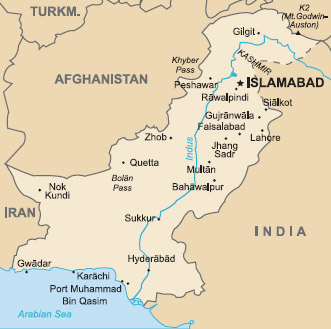China, Pakistan Bypass India as CPEC Digital Routes are Developed
 The China-Pakistan Economic Corridor (CPEC) is a major transportation link between far western Xinjiang Province in China and the port of Gwadar in south-western Pakistan. It has been part of the bilateral agenda for both countries for a number of years now, and is considered by China to be a key element of its Belt & Road Initiative. Much of the analysis of CPEC has seen it as primarily a means for China to gain access to an Indian Ocean port at Gwadar, but recent plans reveal that the CPEC agreement also includes an agreement for China to lease thousands of acres of agricultural land, and to install a full system of monitoring and surveillance in cities from Peshawar to Karachi, with 24-hour video recordings on roads and busy marketplaces for law and order purposes.
The China-Pakistan Economic Corridor (CPEC) is a major transportation link between far western Xinjiang Province in China and the port of Gwadar in south-western Pakistan. It has been part of the bilateral agenda for both countries for a number of years now, and is considered by China to be a key element of its Belt & Road Initiative. Much of the analysis of CPEC has seen it as primarily a means for China to gain access to an Indian Ocean port at Gwadar, but recent plans reveal that the CPEC agreement also includes an agreement for China to lease thousands of acres of agricultural land, and to install a full system of monitoring and surveillance in cities from Peshawar to Karachi, with 24-hour video recordings on roads and busy marketplaces for law and order purposes.
CPEC’s main objector, however, is Delhi, who contests that part of the corridor runs through disputed territory belonging to India, and not Pakistan. This continues to be a main factor of disunity in China-India relations. The two sides also continue to share two further major border area disputes.
However, this has not prevented either China or Pakistan continuing their development of the CPEC. The jointly issued “CPEC plan for Pakistan’s digital future” envisions a project set for completion in 2030, and includes:
- A “new, upgraded fibre optic cable network” that covers Pakistan and “crosses the border to connect directly with China” following the route of the Karakoram Highway.
- The new network will improve communications between the two countries, and allow them to avoid routing data through Europe, the U.S., and India.
- The Plan also says that “China also has in mind its own increasing international telecommunications service demands,” which will necessitate additional international bandwidth.
- The new network should improve internet penetration and speed in Pakistan, as well as provide other landlocked Central Asian countries with alternative communication routes.
- The new China-built networks will, of course, also give the Chinese government enhanced surveillance capacity, not only in Xinjiang, but over all countries that use Chinese optic fiber to connect.
There has as yet been no response from Delhi. However, the spectre of a digitally advanced Pakistani network, enabling it to better co-ordinate with China and other Central Asian nations such as Afghanistan, Tajikistan, Uzbekistan, and Iran – effectively bypassing the existing chaotic connections with India in the creation of future trade routes favoring Pakistan – will not go unnoticed.
About Us
Silk Road Briefing is produced and written by Dezan Shira & Associates. The firm provides governments and corporate businesses worldwide with strategic, legal, tax and operational advisory services to their SMEs and MNCs investing throughout Eurasia and has 28 offices across China, India, Russia and the ASEAN nations, and partner firms in Central Asia. We have specific and long term experience in China and the OBOR countries. For assistance with OBOR related issues, please contact the firm at silkroad@dezshira.com or visit the practice at www.dezshira.com
 Related Reading:
Related Reading:
Silk Road and OBOR Business Intelligence
Dezan Shira & Associates´ Silk Road and OBOR investment brochure offers an introduction to the region and an overview of the services provided by the firm. It is Dezan Shira´s mission to guide investors through the Silk Road´s complex regulatory environment and assist with all aspects of establishing, maintaining and growing business operations in the region.
China’s New Economic Silk Road
This unique and currently only available study into the proposed Silk Road Economic Belt examines the institutional, financial and infrastructure projects that are currently underway and in the planning stage across the entire region. Covering over 60 countries, this book explores the regional reforms, potential problems, opportunities and longer term impact that the Silk Road will have upon Asia, Africa, the Middle East, Europe and the United States.








